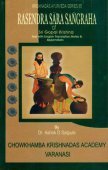Grahani, Grahaṇī: 22 definitions
Introduction:
Grahani means something in Hinduism, Sanskrit, Marathi. If you want to know the exact meaning, history, etymology or English translation of this term then check out the descriptions on this page. Add your comment or reference to a book if you want to contribute to this summary article.
In Hinduism
Ayurveda (science of life)
Rasashastra (Alchemy and Herbo-Mineral preparations)
Source: Wisdom Library: Rasa-śāstraGrahaṇī (ग्रहणी) refers to “chronic diarrhoea” defined in the fourth volume of the Rasajalanidhi (chapter 3, jvarātisāra: fever with diarrhoea). Even after the cure of diarrhoea (atisāra), the digesting heat in the stomach is in a weak condition for some time. Unhealthy diet, taken at this stage, still weakens the digesting, heat which damages the grahaṇī-nāri (nāḍī?) (or the muscle which, by its contraction, retains food in stomach) which, affected by one or more of the three doṣas, discharges, now and then, food from the stomach, either undigested or digested but stinking badly, sometimes in the form of loose and sometimes in the form of formed and solid stool. The attendant evils in this disease are aversion to food, swelling of the limbs, and dullness of the digesting heat.
Kalpa (Formulas, Drug prescriptions and other Medicinal preparations)
Source: Ancient Science of Life: Yogaśataka of Pandita VararuciGrahaṇī (ग्रहणी) refers to “sprue”, and is mentioned in the 10th century Yogaśataka written by Pandita Vararuci.—The Yogaśataka of Pandita Vararuci is an example of this category. This book attracts reader by its very easy language and formulations which can be easily prepared and have small number of herbs. It describes only those formulations which are the most common and can be used in majority conditions of diseases (viz., Grahaṇī).
Decoction of śuṇṭhi, mustā, ativiṣā and guḍūcī is indicated for mandāgni (low digestive power), āmavāta, grahaṇī (sprue) and diseases caused by āma. It is also known as cāturbhadra decoction in Śārṅgadhara-saṃhitā. The famous phalatrikādi decoction which is available in Caraka-saṃhitā is also described using the same words.
Source: Shodhganga: Edition translation and critical study of yogasarasamgrahaGrahaṇī (ग्रहणी) refers to “sprue” and is one of the various diseases mentioned in the 15th-century Yogasārasaṅgraha (Yogasara-saṅgraha) by Vāsudeva: an unpublished Keralite work representing an Ayurvedic compendium of medicinal recipes. The Yogasārasaṃgraha [mentioning grahaṇī] deals with entire recipes in the route of administration, and thus deals with the knowledge of pharmacy (bhaiṣajya-kalpanā) which is a branch of pharmacology (dravyaguṇa).
Unclassified Ayurveda definitions
Source: Wisdom Library: Āyurveda and botanyGrahaṇī (ग्रहणी) is a Sanskrit technical term translating to “dysentery” an inflammation of the intestine potentially leading to severe diarrhea, and is used throughout Ayurvedic literature such as the Caraka-saṃhitā and Suśruta-saṃhitā. Grahaṇī is derived from the Sanskrit word Grahaṇa, the adjective of which literally translates to “seizing, holding”.
Source: Google Books: Essentials of AyurvedaGrahaṇī (ग्रहणी) is the seat of fire where membrane containing pitta is attached. It is here that all types of food are digested by pitta.
Source: archive.org: Vagbhata’s Ashtanga Hridaya Samhita (first 5 chapters)Grahaṇī (ग्रहणी) (cf. grahaṇīdoṣa) is a certain organ at the entrance of the intestinal tract which contains the gastric fire, taking in the undigested food and putting out the digested one; if it is impaired by poor gastric fire, the food passes undigested, bringing about looseness of the bowels. Cf. Aṣṭāṅgasaṃghraha II.3.49 sqq. Hoernle (Bower MS. p. 268) identifies this organ as the duodenum.
Source: archive.org: Science And Technology In Medievel India (Ayurveda)Grahaṇī (ग्रहणी) refers to “muco-enteritis” and is one of the various diseases dealt with in the Dhanvantarīyapathyāpathya, as is mentioned in A. Rahman’s Science and Technology in Medievel India: A bibliography of source materials in Sanskrit, Arabic and Persian.—Ancient and medieval India produced a wide range of scientific manuscripts and major contributions lie in the field of medicine, astronomy and mathematics, besides covering encyclopedic glossaries and technical dictionaries.—The Dhanvantarīyapathyāpathya deals with the treatment of various diseases [e.g., Grahaṇī]. The word pathyāpathya classifies those elements as either beneficial or hurtful in disease.
Source: Research Gate: Internal applications of Vatsanabha (Aconitum ferox wall)Grahanī (ग्रहनी) refers to “sprue” (Coeliac disease: a disease of the small intestine). Medicinal formulations in the management of this condition include 69 references of Vatsanābha usages. Maximum dosage form is Guṭikā (53) in the management of Grahanī. Vatsanābha (Aconitum ferox), although categorized as sthāvara-viṣa (vegetable poisons), has been extensively used in ayurvedic pharmacopoeia.
Source: Ancient Science of Life: Vaidyavallabha: An Authoritative Work on Ayurveda TherapeuticsGrahaṇi (ग्रहणि) refers to a “sprue disorder”, which is dealt with in the 17th-century Vaidyavallabha written by Hastiruci.—The Vaidyavallabha is a work which deals with the treatment and useful for all 8 branches of Ayurveda. The text Vaidyavallabha has been designed based on the need (viz., grahaṇi) of the period of the author, availability of drugs during that time, disease manifesting in that era, socio-economical-cultural-familial-spiritual-aspects of that period Vaidyavallabha.
Source: gurumukhi.ru: Ayurveda glossary of termsGrahaṇī (ग्रहणी):—A part of the gut lying between the stomach and intestines, i. e. , Duodenum.

Āyurveda (आयुर्वेद, ayurveda) is a branch of Indian science dealing with medicine, herbalism, taxology, anatomy, surgery, alchemy and related topics. Traditional practice of Āyurveda in ancient India dates back to at least the first millenium BC. Literature is commonly written in Sanskrit using various poetic metres.
Languages of India and abroad
Marathi-English dictionary
Source: DDSA: The Molesworth Marathi and English Dictionarygrahaṇi (ग्रहणि).—f S Diarrhœa or dysentery. 2 The three smaller intestines, duodenum, ilium, jejunum.
Source: DDSA: The Aryabhusan school dictionary, Marathi-Englishgrahaṇī (ग्रहणी).—f Dysentery, diarrhœa.
Marathi is an Indo-European language having over 70 million native speakers people in (predominantly) Maharashtra India. Marathi, like many other Indo-Aryan languages, evolved from early forms of Prakrit, which itself is a subset of Sanskrit, one of the most ancient languages of the world.
Sanskrit dictionary
Source: DDSA: The practical Sanskrit-English dictionaryGrahaṇi (ग्रहणि) or Grahaṇī (ग्रहणी).—f.
1) An imaginary organ supposed to lie between the stomach and the intestines.
2) The small intestine or that part of the alimentary canal where the bile assists digestion and from which vital warmth is diffused.
3) Diarrhœa, dysentery.
Derivable forms: grahaṇiḥ (ग्रहणिः).
Source: Cologne Digital Sanskrit Dictionaries: Edgerton Buddhist Hybrid Sanskrit DictionaryGrahaṇī (ग्रहणी).—(Sanskrit only as name of an imaginary abdominal organ; Pali gahaṇī app. more loosely used, compare saṃsuddha- gahaṇika, of pure womb or origin; Dīghanikāya (Pali) commentary i.281.10 mātu-gahaṇī kucchīti attho), (belly, womb;) interior (like Sanskrit garbha): in Saddharmapuṇḍarīka 239.3 (prose) read pañcabhiḥ puṣpa- grahaṇī-(so with Kashgar recension and 3 Nepalese mss., ed. °ṇīya)- vedikā-sahasraiḥ svabhyalaṃkṛto (stūpaḥ), adorned with 5000 balconies filled with (containing; Tibetan bkram pa, besprinkled with) flowers.
Source: Cologne Digital Sanskrit Dictionaries: Shabda-Sagara Sanskrit-English DictionaryGrahaṇi (ग्रहणि).—f.
(-ṇiḥ) 1. Diarrhœa, dysentery. 2. The vessels diffusing vital warmth. 3. The small intestines, that part of the alimentary canal where the bile assists digestion. E. grah to seize, ani Unadi affix; also with ṅīp added grahaṇī.
Source: Cologne Digital Sanskrit Dictionaries: Benfey Sanskrit-English DictionaryGrahaṇī (ग्रहणी).—i. e. grahaṇa + ī, f. An organ of the belly, [Suśruta] 2, 443, 12.
Source: Cologne Digital Sanskrit Dictionaries: Monier-Williams Sanskrit-English Dictionary1) Grahaṇī (ग्रहणी):—[from grahaṇa > grah] a f. an imaginary organ supposed to lie between the stomach and the intestines (the small intestines or that part of the alimentary canal where the bile assists digestion and from which vital warmth is said to be diffused), [Suśruta]
2) [v.s. ...] = ṇī-gada, [Aṣṭāṅga-hṛdaya iii, 8; Hemādri’s Caturvarga-cintāmaṇi i, 7]
3) Grahaṇi (ग्रहणि):—[from grah] f. = ṇī, [Uṇādi-sūtra]
4) Grahaṇī (ग्रहणी):—[from grah] b f. of ṇa q.v.
Source: Cologne Digital Sanskrit Dictionaries: Yates Sanskrit-English DictionaryGrahaṇi (ग्रहणि):—(ṇiḥ) 2. f. Diarrhoea, dysentery; the small intestines.
Source: DDSA: Paia-sadda-mahannavo; a comprehensive Prakrit Hindi dictionary (S)Grahaṇī (ग्रहणी) in the Sanskrit language is related to the Prakrit word: Gahaṇī.
[Sanskrit to German]
Sanskrit, also spelled संस्कृतम् (saṃskṛtam), is an ancient language of India commonly seen as the grandmother of the Indo-European language family (even English!). Closely allied with Prakrit and Pali, Sanskrit is more exhaustive in both grammar and terms and has the most extensive collection of literature in the world, greatly surpassing its sister-languages Greek and Latin.
Kannada-English dictionary
Source: Alar: Kannada-English corpusGrahaṇi (ಗ್ರಹಣಿ):—
1) [noun] any of various intestinal inflammations characterised by excessive frequency and looseness of bowel movements; dysentery.
2) [noun] a disease, affecting children, characterised by the bones becoming soft and distorted.
Kannada is a Dravidian language (as opposed to the Indo-European language family) mainly spoken in the southwestern region of India.
See also (Relevant definitions)
Starts with (+1): Grahanibhairava, Grahanicikitsa, Grahanidosha, Grahanigada, Grahanigahendra, Grahanigajakeshari, Grahanigraha, Grahanigrahau, Grahanihara, Grahanikapata, Grahanipradosha, Grahanirmukta, Grahanirnaya, Grahaniroga, Grahanirogin, Grahaniruj, Grahanishardula, Grahanivajrakapata, Grahaniya, Grahaniyata.
Ends with (+3): Abhigrahani, Avagrahani, Bhayagrahani, Cakragrahani, Chakragrahani, Dharmaratnasamgrahani, Grihavagrahani, Havirgrahani, Jambudvipasamgrahani, Kritrimagrahani, Nalasangrahani, Paryayasamgrahani, Pittagrahani, Prajnapanatritiyapadasamgrahani, Raktagrahani, Samgrahagrahani, Samgrahani, Sarvabhutarutagrahani, Sarvagrahani, Sarvasarasamgrahani.
Full-text (+81): Grahanihara, Gahani, Grahaniruj, Grahanidosha, Grahanikapata, Grahaniroga, Grahanigada, Grahanipradosha, Cakragrahani, Samgrahani, Grahanirogin, Avagrahani, Svarnaparpati, Samgrahaniratna, Pancamritaparpati, Sainyanigrahika, Havirgrahani, Samgrahagrahani, Vijayaparpati, Adhyashana.
Relevant text
Search found 16 books and stories containing Grahani, Grahaṇī, Grahaṇi; (plurals include: Grahanis, Grahaṇīs, Grahaṇis). You can also click to the full overview containing English textual excerpts. Below are direct links for the most relevant articles:
Jivanandana of Anandaraya Makhin (Study) (by G. D. Jayalakshmi)
Medicines administered for different diseases < [Chapter 4 - Āyurvedic principles in Jīvanandana Nāṭaka]
Jvara (fever) < [Chapter 4 - Āyurvedic principles in Jīvanandana Nāṭaka]
Act VI (Summary) < [Chapter 3 - Summary of the Play Jīvānandana Nāṭaka]
Atharvaveda and Charaka Samhita (by Laxmi Maji)
Grahaṇī (sprue-syndrome) according to Caraka < [Chapter 4 - Diseases and Remedial measures (described in Caraka-saṃhitā)]
Treatment of Piles (durṇāmā) < [Chapter 3 - Diseases and Remedial measures (described in Atharvaveda)]
Mādhavanidāna (Āyurveda book) < [Chapter 1 - Introduction]
Rasa Jala Nidhi, vol 4: Iatrochemistry (by Bhudeb Mookerjee)
Part 72 - Recipes of certain medicines having no minerals in them < [Chapter III - Jvaratisara fever with diarrhoea]
Part 56 - Treatment for chronic diarrhea (28): Grahani-gajendra rasa < [Chapter III - Jvaratisara fever with diarrhoea]
Part 69 - Treatment for chronic diarrhea (41): Agnisuta rasa < [Chapter III - Jvaratisara fever with diarrhoea]
Bhesajjakkhandhaka (Chapter on Medicine) (by Hin-tak Sik)
Internal Medicine (e): Gastrointestinal Disturbances < [Chapter 5 - Diseases and Treatments in the Chapter on Medicine]
Expiatory Rites in Keralite Tantra (by T. S. Syamkumar)
4.2. Diseases and Expiatory Rites < [Chapter 1 - Expiatory Rites: Concept and Evolution]
Charaka Samhita (English translation) (by Shree Gulabkunverba Ayurvedic Society)
Chapter 15 - The therapeutics of Assimilation disorders (grahani-dosha-cikitsa) < [Cikitsasthana (Cikitsa Sthana) — Section on Therapeutics]
Chapter 19 - The Eight Abdominal affections (udara-roga) < [Sutrasthana (Sutra Sthana) — General Principles]
Related products
(+3 more products available)





